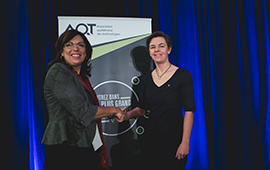MENTOR SUPPORT PROJECT FOR QUEBEC WOMEN PROFESSIONALS
 The Government of Canada’s Labour Program and Status of Women Canada have chosen the Association Québécoise des technologies (AQT) to initiate a project to advance women professionals and entrepreneurs heading small and medium-sized companies in Quebec’s information and communications technology industry. After a research and consultation process and with the involvement of guides from carefully chosen environments, a mentorship model will be developed that the association can integrate into its regular services.
The Government of Canada’s Labour Program and Status of Women Canada have chosen the Association Québécoise des technologies (AQT) to initiate a project to advance women professionals and entrepreneurs heading small and medium-sized companies in Quebec’s information and communications technology industry. After a research and consultation process and with the involvement of guides from carefully chosen environments, a mentorship model will be developed that the association can integrate into its regular services.
Budget: $250,000
Duration: 30 months
Objectives:
The objective is to understand the main obstacles and to use the information collected to develop a mentorship model adapted to women’s specific situations, This mentorship model will give them access to higher-level jobs in their organizations and provide them with support in their entrepreneurial pursuits, and in so doing contribute to their economic advancement.
In figures:
- 400 women will be consulted to gather information and define an optimal mentorship model.
- 30 women will participate in the discussion groups.
- 12 women will be mentored.
Each of these women will receive feedback throughout the various stages of the project to facilitate their rise to positions of influence.
DID YOU KNOW …?
- The main reason women are kept from leadership or entrepreneurial roles is family.
- Their known risk aversion is also a major obstacle to occupying roles with greater responsibility.
- According to data gathered by the AQT, companies headed by women are smaller, with 80% of their companies numbering fewer than 30 employees (the overall average is 37). Consequently, their sales are 2.1 times smaller than the average.
- They are also less likely to use advisory committees and boards of directors in their companies, which are known to be an important factor in success.
- Family support, but most of all access to a mentor, is the guarantee of a woman’s success.
STAGES AND IMPLEMENTATION
- Establishing partnerships
Establishing partnerships with chosen groups and organizations, bringing in experts on women’s rights and mentorship - Evaluating needs, analyzing the issue and defining the problems
This stage of the project is intended to determine needs, and shortfalls between the desired conditions and the actual ones. - Exploring a mentorship model
Designing an optimal mentorship program for—and adapted to the challenges of—the ICT industry. - Implementing the model
Forming dyads (mentor /mentee pairs) that will provide a coaching framework for the selected women. - Pooling knowledge
Establishing a reference centre (intranet) offering support tools and a mentorship kit. - Evaluating the project externally
Evaluating the workings of the program, and the satisfaction of participants and mentors. Validating the level of learning and the benefits for both mentees and businesses.